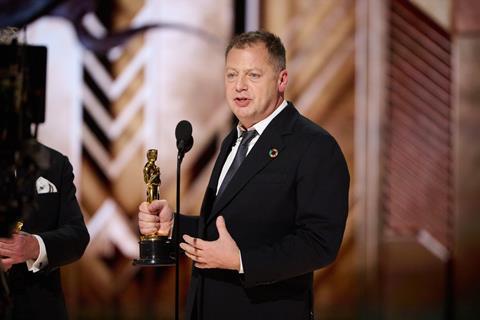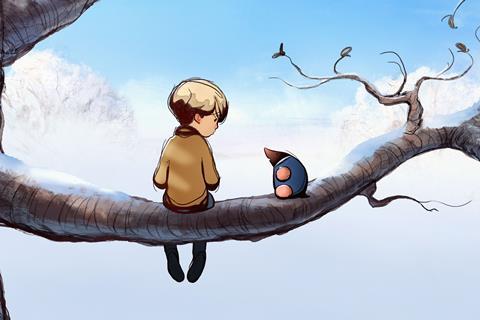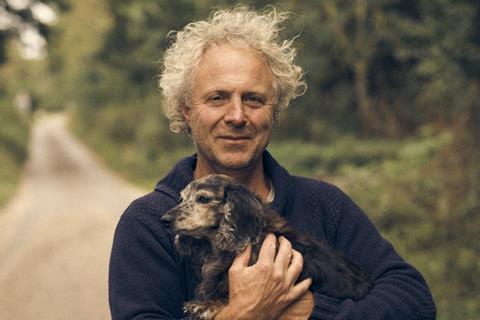
By his own estimation, Matthew Freud reckons his PR agency Freud Communications has provided behind-the-scenes publicity and marketing support to around 1,000 films since opening back in 1985.
A few weeks ago, however, it was Freud himself at the centre of attention – on stage at the Academy Awards where he received an Oscar for producing the short film animation of Charlie Mackesy’s best-selling book, The Boy, The Mole, The Fox And The Horse.
Speaking to Screen at his company HQ back in London – where his Oscar sits proudly on a cabinet shelf in his office, alongside a BAFTA for the animation too – Freud reflects on his acceptance speech, where he apologised to “my children, my girlfriend and my colleagues at Freuds for basically being absent over the last two years” while producing the film.
He would have offered more apologies, too, had it had not been drummed into nominees beforehand to keep time on stage brief. (And, in the heat of the moment, he forgot to thank Apple and the BBC, which had aired the film.)
“I was also going to apologise to all of the people who I’ve worked for the last 40 years who hadn’t got Oscars,” says Freud. “Some of whom were cross. I mean, like really cross – there was a little bit of outrage. It turns out most people don’t have Oscars.”
They shouldn’t fear, however, that Freud is going to leap wholeheartedly from the world of PR into producing full time.
Looking back on making the film, which was self-financed, Freud calls it a “pretty consuming two years”.
He references My Year Of Dicks, one of the animated films nominated for an Oscar alongside The Boy, The Mole, The Fox And The Horse. “That sounds a bit like my last couple of years. I didn’t love it. I genuinely didn’t love it.”
That’s not because of the team he worked with, who he praises fulsomely – but more because of the non-creative processes involved in producing, such as legal, compliance and contracting. He cites the technical delivery requirements to international partner Apple: “There were like 1,000 deliverables – it was nuts.”
He was also worried about the film being a disappointment to fans of the best-selling book, a collection of Mackesy’s drawings and words which encourage kindness and support. It seemed to provide a balm and an uplift to readers of all ages when it was published in late 2019, and became even more relevant during the pandemic.
“The jeopardy was about failing the work, because the book had been so meaningful to people,” says Freud.
From the beginning

Freud leans back in his chair as he starts to tell the story of The Boy, The Mole, The Fox And The Horse’s journey to the screen. He’s an engaging talker; the story he tells seems to be set largely within a world of famous friends and big houses.
Even before he begins, one feels slightly swept up in Freud’s world. Walking into the reception of his agency, there are artworks by Damon Hirst and Banksy through to exhibits such as an Enigma machine, used by codebreakers in the Second World War, and the bass drum from the cover of the Beatles’ Sgt. Pepper’s album.
Freud goes back to the beginning, when he set up the agency aged 21 (“I had just two clients. One was an Irish humming band called Clannad. The other was Uri Geller, the spoon-bender”).
His first film job was working as a unit publicist on Aria, an anthology film produced by Don Boyd (who happened to be staying at Freud’s flat) consisting of ten short films by directors such as Julien Temple, Derek Jarman, Robert Altman, Jean-Luc Godard and Ken Russell.
Freud calls it an incredible education: “I spent a year being on 10 film sets with 10 extraordinary directors.” His company went on to represent key film studios, offering unit and release publicity, looking after red carpets and events, and handling corporate PR. Freuds itself grew out of these entertainment roots, going on to work with major companies and becoming a well-known brand in itself within the PR world.
Meeting Mackesy
Film production is a new departure for Freud, who first met Mackesy in “1989 or 1990”, when the “young, very scruffy artist” came to lunch at his then house in West Sussex. The pair became friends, with the artist staying over in Freud’s poolhouse. “He’s just very kind, sweet and funny. He literally became part of the furniture.” Freud says the two of them have “spoken every day for 30 years”.
After Mackesy started creating his animal drawings and they became a hit on Instagram, Freud introduced him to Gail Rebuck, chair of Penguin Random House. “She came to a little Christmas thing that I do in the chapel at Burford,” recalls Freud. “We’re talking to Gail, and she said, ‘There is probably a book in this.’”
“I remember telling Charlie it would sell a million copies,” adds Freud, who helped negotiate the publishing deal with Penguin Random House. Even before then, prints of Mackesy’s drawings were selling rapidly and generating plenty of revenue. The publishing deal was for a single illustrated picture book, with Mackesy keeping hold of all other underlying rights. “The first reasonably clever thing I did when negotiating with Penguin Random House was to say [to Charlie], ‘Get the Downton Abbey Christmas annual contract because that is how much IP of this you are going to own.’”
The first print run was 10,000 – but the book just grew and grew. It’s now the UK’s bestselling adult hardback since records began and has been translated into 50 languages.
“Guess what when you have a hit book? You get calls asking if the film rights are available,” says Freud. He logged more than 220 expressions of interest for the adaptation rights, including from every studio and streamer.
Teaming up
By this time, Freud had become a business partner with Mackesy. “I was just trying to help a mate when all the film conversation started,” he says. “I was suddenly spending quite a lot of my time negotiating translation rights for the book and kept trying to palm him off on agents. And he just didn’t like them, or show up to the meetings, or didn’t want to do it.”
So, they teamed up. “We had one vaguely awkward conversation, where I sort of said, ‘Maybe, I’ll take that.’ And he said, ‘Yeah, that’s what I was thinking.’ And that was the only conversation we ever had about how we work together.” Freud drew on his company’s inhouse publicity, talent, legal and finance teams to support Mackesy. Suddenly, the artist had a team around him.
Before deciding on the film rights, Freud called Harry Potter producer David Heyman (“an old friend, we were at school together”) for his advice. “David said, ‘Until you are sitting in front of the person who is going to make it, don’t agree to anything.’”
They eventually teamed in 2020 with Cara Speller, an Oscar-nominated animation producer known for her work with animated band Gorillaz, to form their own production company NoneMore Productions (the name comes from a line in the movie This Is Spinal Tap).
Paddington 2 writer Jon Croker worked with Mackesy on the script. Freud’s brother in-law Richard Curtis also had “a little hand” in the adaptation. “He probably contributed the most important two words of the films,” says Freud. “The book has no narrative – it’s just a seemingly disjointed collection of drawings. Richard said, ‘What’s going on here?’ Then, he said, ‘The boy is lost.’ And that is the entire narrative.”
Into production

The project started to move towards production, with Mackesy working out of a barn owned by Freud in Suffolk and animators being hired.
By this point, Freud had spoken with BBC chief content officer Charlotte Moore, thinking of the BBC as “the right UK partner”. He thought Warner Media/HBO might be a good international partner and teamed with Bad Robot’s JJ Abrams and Hannah Minghella as producers. “It was envisaged that they would deliver the US part, and we’d deliver the UK part.”
But, by the time production started, no studios, streamers or broadcasters had put any money into the film.
Freud was in a hurry though – neither he nor Mackesy wanted to “spend a year trying to negotiate a deal”. Neither did they want to hand over control or give away ownership of the project. “There were some early conversations with Warners – they were keen on it but it was clear that they would want rights, first looks on different things, possibly final cut. And so, the conversations kept on going, and we kept on making the film, and then suddenly we were employing about 100 people.”
In total, some 120 people worked on the film. Production started during the pandemic, with the artists working remotely. The film itself was entirely hand-drawn. Mackesy wanted every frame to be a piece of art in its own right, says Freud, “because he’s an artist”. In total, the 30-minute film required 45,000 hand-drawn pictures.
The budget started to rise during production, too. It’s understood that it increased from an initial estimate of £2m to around £5m. “It turns out quadrupeds are really hard to animate. Who knew?” says Freud. Peter Baynton, whose credits include The Tiger Who Came To Tea, was promoted from head of animation to co-director alongside Mackesy. “We wanted Charlie to direct it, but clearly he needed a more technically capable partner,” recalls Freud.
Isobel Waller-Bridge came on board to create the music. The casting was also agreed, with Gabriel Byrne, Idris Elba, Tom Hollander and a young Jude Coward Nicoll voicing the characters.
Deals, at last
Still there was no deal in place. “We just got further and further down the line,” recalls Freud. “It ended up being a negative pick-up.”
The BBC acquired the film, and set a TX date for Christmas Eve, 2022. But, by that September, there was no international deal agreed. A “punchy” offer had been made by WarnerMedia, but this was 10 days before David Zaslav took over as head of the merged Warner Bros Discovery. Freud says he turned it down, fearing that it would not progress under the incoming regime. As it was, he says, “the guy who made it was sacked a week later, and so was his boss.”
Going into autumn 2022, there was still no international deal. One was needed, not only to recoup the money spent on making the film, but also because Freud had already sold the book version of the animated film. “We had a worldwide network of publishing people ready to publish the book of the film. And if it wasn’t on TV, that would have been quite hard.”
So he approached Apple. It was a two-pronged approach. He got in touch with Jay Hunt, Apple’s creative director, worldwide video, Europe. He also asked “one of my best friends,” Jony Ive, the former Apple chief design officer, to send the almost-finished animation to Apple boss Tim Cook. The two-pronged approach worked. “I think Apple was definitely the natural partner for it,” says Freud.
Looking ahead
Reflecting on the process of producing and financing the film, Freud says it was so consuming “because I didn’t know how to do it”. He credits Speller for “running the animation process completely brilliantly” and Minghella for her creative input.
Looking ahead, he says he has “zero interest in a film or TV production for its own sake”. But he is interested in TV and film as a powerful medium for change.
He cites The Real Mo Farah, produced by Atomized, one of the Freuds group companies, about how the Olympic gold medal winner was illegally trafficked to the UK at the age of nine to be a domestic servant. Freud thinks this kind of trafficking will be much harder in light of the BBC TV documentary.
The Boy, The Mole, The Fox And The Horse is part of a wider set of work that the company has done around mental health in recent years, including helping to launch the NHS’s Every Mind Matters campaign. But, says Freud, “I don’t think anything I will ever be involved in will do more to help people than that book or film.”
Given the surname (he’s the great-grandson of Sigmund Freud, the founder of psychoanalysis), Freud says he actively avoided being associated with mental health as a subject for years. “But I have definitely stopped running away from it.”
This, he says, is one of the reasons for his apologetic Oscars speech. “If you’ve got a famous surname, then you get a reasonable attention, which you feel enormously undeserving of.”
So, how was it going up on the stage with Mackesy to collect the Oscar? “Weird – I made myself do it, because I thought I worked really hard on this. And I did the thing that no one ever does, which is to put their own money into something.”
Freud expresses his gratitude to all of the people who helped make the film, as well as official partners Apple, BBC and Bad Robot. “But at the heart of it, it was just me and Charlie, making it up as we went along – and getting away with it.”






![The Brightest SunScreen[Courtesy HKIFF]](https://d1nslcd7m2225b.cloudfront.net/Pictures/274x183/3/5/0/1448350_thebrightestsunscreencourtesyhkiff_312678.jpg)


















No comments yet